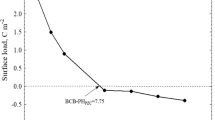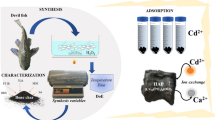Abstract
In this study, bone chars were obtained from an alien aquatic species “devilfish” bones by pyrolysis of 500–800 °C. Bone chars were evaluated as a sustainable adsorbent of fluoride, and it was found pyrolyzed bone char at 500 °C adsorbed the most amount of fluoride. Thermodynamic parameters of fluoride adsorption on devilfish bone chars were estimated as ΔH° = 7.213 kJ mol−1, ΔG° = 23.61 kJ mol−1, and ΔS° = 103.4 J mol−1 K−1 indicating that adsorption is endothermic, spontaneous, and with a great affinity of fluoride on bone char. The fluoride desorption study showed that fluoride is desorbed from the material of 0.24 to 20.06%, so the adsorption is considered to be partly reversible. The regeneration of the bone char at 400, 500, and 600 °C was studied, and it was noted that its adsorption capacity decreases slightly, so it could be considered appropriate for the use in water treatment technologies. Adsorption of fluorides from drinking well water of a rural community with dental fluorosis problems and high levels of fluoride in water revealed that by increasing the amount of the bone char of 0.05 to 0.8 g, the disposal of fluoride increases from 69.1 to 98.7%. Lastly, it was established that the bone char synthesized from devilfish is a low-cost, viable, sustainable material to remove fluorides from water and represents an environmental management strategy of this alien species.












Similar content being viewed by others
Data availability
The datasets used and/or analyzed during the current study are available from the corresponding author on reasonable request.
References
Abeykoon, K. G. M. D., Dunuweera, S. P., Liyanage, D. N. D., Rajapakse, R. M. G. (2020). Removal of fluoride from aqueous solution by porous vaterite calcium carbonate nanoparticles. Materials Research Express, 7(3). https://doi.org/10.1088/2053-1591/ab7692.
Ahmad, S. Z. N., Hamdan, R., Mohamed, W. A. W., Othman, N., & Zin, N. S. M. (2018). Chemical composition, pH value, and points of zero charge of high calcium and high iron electric arc furnace slag. International Journal of Engineering and Technology (UAE), 7(3.23 Special Issue 23), 1–4.
Ahmadi, S., Mesbah, M., Igwegbe, A. C., Ezeliora, C. D., Osagie, C., Khan, N. A., Dotto, G. L., Salari, M., & Dehghani, M. H. (2021). Sono electro-chemical synthesis of LaFeO3 nanoparticles for the removal of fluoride: Optimization and modeling using RSM, ANN and GA tools. Journal of Environmental Chemical Engineering, 9(4), 105320. https://doi.org/10.1016/j.jece.2021.105320.
Akafu, T., Chimdi, A., Gomoro, K. (2019). Removal of fluoride from drinking water by sorption using diatomite modified with aluminum hydroxide. Journal of Analytical Methods in Chemistry. https://doi.org/10.1155/2019/4831926.
Alkurdi, S. S. A., Al-Juboori, R. A., Bundschuh, J., & Hamawand, I. (2019). Bone char as a green sorbent for removing health threatening fluoride from drinking water. Environment International, 127(March), 704–719. https://doi.org/10.1016/j.envint.2019.03.065.
Assaoui, J., Hatim, Z., & Kheribeche, A. (2020). Synthesis and characterization of aluminum-based adsorbent and application in fluoride removal from aqueous solution. Mediterranean Journal of Chemistry, 10(1), 46. https://doi.org/10.13171/mjc101020291172ja.
Bedin, K. C., de Azevedo, S. P., Leandro, P. K. T., Cazetta, A. L., & Almeida, V. C. (2017). Bone char prepared by CO2 atmosphere: Preparation optimization and adsorption studies of Remazol Brilliant Blue R. Journal of Cleaner Production, 161, 288–298. https://doi.org/10.1016/j.jclepro.2017.05.093.
Bhatnagar, A., Kumar, E., & Sillanpää, M. (2011). Fluoride removal from water by adsorption—A review. Chemical Engineering Journal, 171(3), 811–840. https://doi.org/10.1016/j.cej.2011.05.028.
Cooney, D. O. (1998). Adsorption design for wastewater treatment. C. Press (ed.) 2nd edn.
Dotto, G. L., & McKay, G. (2020). Current scenario and challenges in adsorption for water treatment. Journal of Environmental Chemical Engineering, 8, 103988. https://doi.org/10.1016/j.jece.2020.103988.
Ellingham, S. T. D., Thompson, T. J. U., & Islam, M. (2015). Thermogravimetric analysis of property changes and weight loss in incinerated bone. Palaeogeography, Palaeoclimatology, Palaeoecology, 438, 239–244. https://doi.org/10.1016/j.palaeo.2015.08.009.
Emmanuel, M., Wilson-Lamayi, D., Shehu, Z., Solomon-Kwarson, P. (2018). Equilibrium, isotherm and kinetic studies of flouride adsorption equilibrium, isotherm and kinetic studies of flouride adsorption on activated rice. Innovat International Journal of Medical & Pharmaceutical Sciences.
Fan, Z., Gao, Y., Ning, X., Pan, F., & Ming, J. (2019). Adsorption of fluoride ions from water by SF/PP nonwoven fabrics. Fibers and Polymers, 20(4), 863–867. https://doi.org/10.1007/s12221-019-1085-0.
Figueiredo, J. L., Pereira, M. F. R., Freitas, M. M. A., & Órfão, J. J. M. (1999). Modification of the surface chemistry of activated carbons. Carbon, 37(9), 1379–1389. https://doi.org/10.1016/S0008-6223(98)00333-9.
Garcia-Gonzales, A., Riveron-Giro, F., & Barba, E. (2017). Primer registro para Cuba del pez invasor Pterygoplichthys pardalis (Siluriformes : Loricariidae) first record of the invasive fish Pterygoplichthys pardalis. Revista Cubana De Ciencias Biologicas, 5, 1–6.
Isaacs-Páez, E. D., Medellin-Castillo, N., Manríquez-Guerrero, F., Cercado, B. (2019). Characterization of bone char and carbon xerogel as sustainable alternative bioelectrodes for bioelectrochemical systems. Waste Biomass Valorization. https://doi.org/10.1007/s12649-019-00817-4.
Jalil, S. N. A., Amri, N., Ajien, A. A., Ismail, N. F., Ballinger, B. (2019). A hybrid electrocoagulation-adsorption process for fluoride removal from semiconductor wastewater. Journal of Physics: Conference Series, 1349(1). https://doi.org/10.1088/1742-6596/1349/1/012056.
Kaseva, M. E. (2006). Contribution of trona (magadi) into excessive fluorosis—A case study in Maji ya Chai ward, northern Tanzania. Science of the Total Environment, 366(1), 92–100. https://doi.org/10.1016/j.scitotenv.2005.08.049.
Kini, U., & Nandeesh, B. N. (2012). Physiology of bone formation, remodeling, and metabolism. Radionuclide Hybrid Bone Imaging, 9783642024, 1–1046. https://doi.org/10.1007/978-3-642-02400-9.
Kumar, P., Prajapati, A. K., Dixit, S., Yadav, V. L. (2019). Adsorption of fluoride from aqueous solution using biochar prepared from waste peanut hull. Materials Research Express, 6(12). https://doi.org/10.1088/2053-1591/ab6ca0.
Ledon, J. M., Del Razo, L. M., Velasco, M. N. (2018). Hacia el cumplimiento del Derecho Humano al Agua. Arsénico y fluoruro del agua: Riesgos y perspectivas desde la Sociedad civil y la academia en México. In Secretaría de Gobernación, Comisión de Hábitat, Medio Ambiente y Sostenibilidad.
Maldonado, E. J., López, U., Salinas, R. M., González, N., Cuenca, C., Jiménez, R., & Hernández, J. (2015). Contenido de metales pesados en músculo de pez diablo Pterygoplichthys pardalis. Rev Iberoam Ciencias, 2, 67–73.
Medellin-Castillo, N. A., Padilla-Ortega, E., Tovar-García, L. D., Leyva-Ramos, R., Ocampo-Pérez, R., Carrasco-Marín, F., & Berber-Mendoza, M. S. (2016). Removal of fluoride from aqueous solution using acid and thermally treated bone char. Adsorption, 22(7), 951–961. https://doi.org/10.1007/s10450-016-9802-0.
Medellin-Castillo, N. A., Cruz-Briano, S. A., Leyva-Ramos, R., Moreno-Piraján, J. C., Torres-Dosal, A., Giraldo-Gutiérrez, L., Labrada-Delgado, G. J., Pérez, R. O., Rodriguez-Estupiñan, J. P., Reyes Lopez, S. Y., Berber Mendoza, M. S. (2020). Use of bone char prepared from an invasive species, pleco fish (Pterygoplichthys spp.), to remove fluoride and Cadmium(II) in water. Journal of Environmental Management, 256. https://doi.org/10.1016/j.jenvman.2019.109956.
Murillo, Y. S., Giraldo, L., & Moreno, J. C. (2012). Obtención de materiales porosos a partir de huesos de pollo y porcino para la adsorción de 2,4-dinitrofenol. Afinidad, 68(556), 447–452.
Nigri, E. M., Santos, A. L. A., Bhatnagar, A., & Rocha, S. D. F. (2019). Chemical regeneration of bone char associated with a continuous system for defluoridation of water. Brazilian Journal of Chemical Engineering, 36(4), 1631–1643. https://doi.org/10.1590/0104-6632.20190364s20180258.
Otazo-Sánchez, E. M., Navarro-Frometá, A. E., Singh, V. P. (2020). Water availability and management in Mexico. In Water Science and Technology Library. https://doi.org/10.1007/978-3-030-24962-5.
Pigatto, R. S., Franco, D. S. P., Netto, M. S., Carissimi, E., Oliveira, L. F. S., Jahn, S. L., & Dotto, G. L. (2020). An eco-friendly and low-cost strategy for groundwater defluorination: Adsorption of fluoride onto calcinated sludge. Journal of Environmental Chemical Engineering, 8, 104546. https://doi.org/10.1016/j.jece.2020.104546.
Purevsuren, B., Avid, B., Narangerel, J., Gerelmaa, T., & Davaajav, Y. (2004). Investigation on the pyrolysis products from animal bone. Journal of Materials Science, 39(2), 737–740. https://doi.org/10.1023/b:jmsc.0000011545.51724.ad.
Purevsuren, B., Davaajav, Y., Namkhainorov, J., & Genadiev, V. (2017). Pyrolysis of animal bone, characterization of the obtained char and tar and application of bone tar for crosslinking of epoxy resin. Bulgarian Chemical Communications, 49(1), 34–39.
Quintáns-Fondo, A., Ferreira-Coelho, G., Arias-Estévez, M., Nóvoa-Muñoz, J. C., Fernández-Calviño, D., Álvarez-Rodríguez, E., Fernández-Sanjurjo, M., Núñez-Delgado, A. (2019). Chromium VI and fluoride competitive adsorption on different soils and by-products. Processes, 1–13. https://doi.org/10.3390/pr7100748.
Ríos-Muñoz, C. A. (2015). Depredación de pez diablo (Loricariidae: Pterygoplichthys) por el cormorán oliváceo (Phalacrocorax brasilianus) en Villahermosa, Tabasco, México. Huitzil, 16(2), 62–65. https://doi.org/10.28947/hrmo.2015.16.2.68.
Rogers, K. D., & Daniels, P. (2002). An X-ray diffraction study of the effects of heat treatment on bone mineral microstructure. Biomaterials, 23(12), 2577–2585. https://doi.org/10.1016/S0142-9612(01)00395-7.
RosnaeniElfidasari, D., & Fahmi, M. (2017). DNA barcodes of the Pleco (Loricariidae, Pterygoplichthys) in the Ciliwung River. International Journal of Advanced Research, 5(2), 33–45. https://doi.org/10.21474/ijar01/3113.
Sandoval-Huerta, E. R., Madrigal-Guridi, X., García-Meraz, A., Dimas-Mora, N. I., & Domínguez-Domínguez, O. (2012). New record of Pterygoplichthys disjunctivus (Actinopterygii: Loricariidae) in the mouth of Coahuayana River, Coahuayana, Michoacán, Mexico. Revista Mexicana De Biodiversidad, 83(1), 294–297.
Terasaka, S., Kamitakahara, M., Yokoi, T., & Ioku, K. (2014). Effect of preparation temperature on the ability of bone char to remove fluoride ion and organic contaminants. Journal of the Ceramic Society of Japan, 122(1432), 995–999. https://doi.org/10.2109/jcersj2.122.995.
Teusner, A., Butler, R., & Le Clech, P. (2016). Impact of pretreatment on defluoridation of drinking water by bone char adsorption. Journal of Humanitarian Engineering, 4(1), 26–31. https://doi.org/10.36479/jhe.v4i1.48.
Thomas, A. C., Tank, S., Nguyen, P. L., Ponce, J., Sinnesael, M., Goldberg, C. S. (2019). A system for rapid eDNA detection of aquatic invasive species. Environ DNA. https://doi.org/10.1002/edn3.25.
World Health Organization (WHO). (2017). Guidelines for drinking-water quality, 4th edition, incorporating the 1st addendum.
Zúñiga-Muro, N. M., Bonilla-Petriciolet, A., Mendoza-Castillo, D. I., Reynel-Ávila, H. E., & Tapia-Picazo, J. C. (2017). Fluoride adsorption properties of cerium-containing bone char. Journal of Fluorine Chemistry, 197, 63–73. https://doi.org/10.1016/j.jfluchem.2017.03.004.
Acknowledgements
Dr. Gladis Judith Labrada Delgado for her contribution to the SEM analysis carried out at IPICyT. Prof. Dr. Juan Carlos Moreno-Piraján also appreciates the financial support granted through the research project number INV-2019-91-1905 from the Research Vice-Rectory of the Universidad de Los Andes.
Funding
This work was supported by Consejo Nacional de Ciencia y Tecnología, CONACyT, Mexico, under grant nos. CB-2016–286990 and PN-2016–3947.
Author information
Authors and Affiliations
Contributions
Sergio Armando Cruz-Briano: investigation, methodology, and writing—original draft. Nahum Andrés Medellín-Castillo: conceptualization, methodology, validation, resources, writing—original draft, writing—review and editing, visualization, supervision, project administration, and funding acquisition. Arturo Torres-Dosal: investigation. Roberto Leyva-Ramos: conceptualization, validation, resources, and writing—review and editing. Juan Carlos Moreno-Piraján: validation and writing—review and editing. Liliana Giraldo-Gutiérrez: validation. Paola Elizabeth Díaz-Flores: methodology, writing—review and editing, and visualization. Simón Yobanny Reyes-López: resources and validation. Raúl Ocampo-Pérez: investigation, writing—review, and editing.
Corresponding author
Ethics declarations
Ethics Approval and Consent to Participate
Not applicable.
Consent for Publication
Not applicable.
Competing Interests
The authors declare no competing interests.
Additional information
Publisher's Note
Springer Nature remains neutral with regard to jurisdictional claims in published maps and institutional affiliations.
Rights and permissions
About this article
Cite this article
Cruz-Briano, S.A., Medellín-Castillo, N.A., Torres-Dosal, A. et al. Bone Char from an Invasive Aquatic Specie as a Green Adsorbent for Fluoride Removal in Drinking Water. Water Air Soil Pollut 232, 346 (2021). https://doi.org/10.1007/s11270-021-05286-x
Received:
Accepted:
Published:
DOI: https://doi.org/10.1007/s11270-021-05286-x




